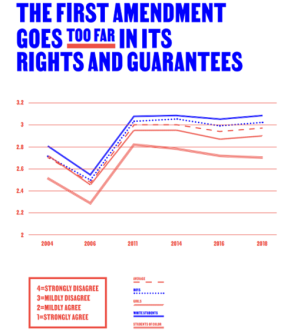Overall, high school students show more support for the First Amendment today than they did 15 years ago—but girls and students of color are more likely than boys and white students to say the amendment “goes too far in the rights it guarantees.”
That comes from a report published last week by the John S. and James L. Knight Foundation that looks at trends from seven surveys administered to high school students between 2004 and 2018. More than 100,000 high school students responded to the first survey in 2004, and subsequent surveys involved about 10,000 students each.

According to the most recent survey, from 2018, 26 percent of students agreed that “the First Amendment goes too far in the rights it guarantees"—down from 45 percent who said the same in 2006.
While most students still favorthe First Amendment’s rights and guarantees, the new report points to a growing divide on the topic between boys and white students in one direction and girls and students of color in the other. The 2018 report, for example, shows that agreement with the statement that the First Amendment “goes too far” stood at 40 percent among black non-Hispanic students, 35 percent among white Hispanic students, 33 percent of Asian students, and 22 percent of white students.

“It is pretty worrying that there is starting to be a greater divergence along the lines of race and along the lines of gender,” said John Wihbey, a co-author of the newest report. “And it’s particularly worrying in light of our current political climate where so many questions around race and gender are being worked out.”
The race-related differences in support span all the study years, and the differences by gender started in 2011.
The authors also found a significant correlation between support for the First Amendment and course work. Wihbey said that, though it’s not an even pattern, students who said they had some sort of classroom engagement with the First Amendment are more likely to be supportive of specific First Amendment rights.
“You would expect, and it would stand to reason that, the more classroom education programing you do around the Constitution, what the rights mean, how they’ve played out in practice, whether it’s through a civics curriculum or a history class, that students would be more informed, probably more likely to support the basic tenets of the First Amendment,” Wihbey said.
Of the students who took the 2018 survey, 64 percent had taken a class that dealt with the First Amendment.
The researchers also noticed that students on average tend to be more supportive of holding websites accountable for offensive content than they are of schools disciplining students for doing much the same thing on social media.
But the 2018 survey shows that similar proportions of students favor assigning blame to both schools and websites. Twenty-six percent of students said they “strongly agree” or “mildly agree” that websites should be disciplined for posting offensive content and 28 percent said that they either “strongly agree” or “mildly agree” students should be disciplined by schools. Overall, the newest report said that 47 percent of students separately agree that social media companies “should be responsible for limiting hate speech on their platforms.”
“I guess it’s possible to be a very big supporter of the First Amendment but think that there are certain types of things that are going on online that maybe we should address...through norms and through policies by the companies themselves,” Wihbey said.
Images: The Knight Foundation